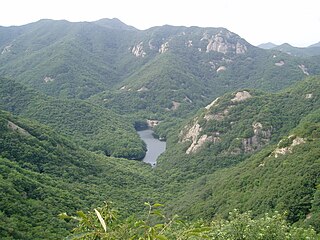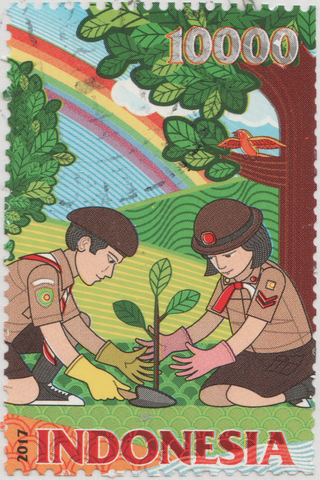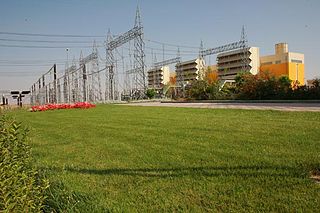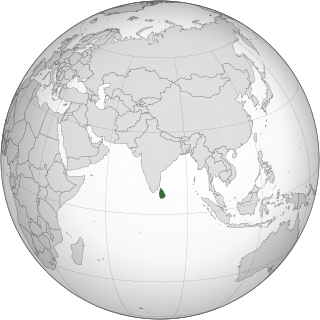
Dust is made of fine particles of solid matter. On Earth, it generally consists of particles in the atmosphere that come from various sources such as soil lifted by wind, volcanic eruptions, and pollution. Dust in homes is composed of about 20–50% dead skin cells. The rest, and in offices and other built environments, is composed of small amounts of plant pollen, human hairs, animal fur, textile fibers, paper fibers, minerals from outdoor soil, burnt meteorite particles, and many other materials which may be found in the local environment.

The environment of South Korea is the natural environment of South Korea, which occupies the southern half of the Korean peninsula. Environment - current issues: air pollution in large cities; water pollution from the discharge of sewage and industrial effluents; acid rain; drift net fishing.

Environmental issues in Indonesia are associated with the country's high population density and rapid industrialisation, and they are often given a lower priority due to high poverty levels, and an under-resourced governance.
Environmental issues in Pakistan include air pollution, water pollution, noise pollution, climate change, pesticide misuse, soil erosion, natural disasters, desertification and flooding. According to the 2020 edition of the environmental performance index (EPI) ranking released by Yale Center for Environmental Law & Policy, Pakistan ranks 142 with an EPI score of 33.1, an increase of 6.1 over a 10-year period. It ranked 180 in terms of air quality. The climatic changes and global warming are the most alarming issues risking millions of lives across the country. The major reasons of these environmental issues are carbon emissions, population explosion, and deforestation.

African environmental issues are caused by human impacts on the natural environment and affect humans and nearly all forms of life. Issues include deforestation, soil degradation, air pollution, water pollution, garbage pollution, climate change and water scarcity. These issues result in environmental conflict and are connected to broader social struggles for democracy and sovereignty.
As for many developing countries, health issues in Iran stem from a variety of reasons: namely, water and sanitation, diet and fitness, various addictions, mental fitness, communicable diseases, hygiene and the environment.

The aim of water security is to make the most of water's benefits for humans and ecosystems. The second aim is to limit the risks of destructive impacts of water to an acceptable level. These risks include for example too much water (flood), too little water or poor quality (polluted) water. People who live with a high level of water security always have access to "an acceptable quantity and quality of water for health, livelihoods and production". For example, access to water, sanitation and hygiene services is one part of water security. Some organizations use the term water security more narrowly for water supply aspects only.

The environment of Trinidad and Tobago reflects the interaction between its biotic diversity, high population density, and industrialised economy.
The environmental impact of agriculture is the effect that different farming practices have on the ecosystems around them, and how those effects can be traced back to those practices. The environmental impact of agriculture varies widely based on practices employed by farmers and by the scale of practice. Farming communities that try to reduce environmental impacts through modifying their practices will adopt sustainable agriculture practices. The negative impact of agriculture is an old issue that remains a concern even as experts design innovative means to reduce destruction and enhance eco-efficiency. Though some pastoralism is environmentally positive, modern animal agriculture practices tend to be more environmentally destructive than agricultural practices focused on fruits, vegetables and other biomass. The emissions of ammonia from cattle waste continue to raise concerns over environmental pollution.

The economy of Iran includes a lot of subsidies. Food items, such as flour and cooking oil, are subsidized, along with fuels such as gasoline. However cutting subsidies can cause civil unrest.

Water resource policy, sometimes called water resource management or water management, encompasses the policy-making processes and legislation that affect the collection, preparation, use, disposal, and protection of water resources. The long-term viability of water supply systems poses a significant challenge as a result of water resource depletion, climate change, and population expansion.

Water scarcity in Iran is caused by high climatic variability, uneven distribution of water, over exploitation of available water resources,and prioritization of economic development. Water scarcity in Iran is further exacerbated by climate change.

In Turkey, air pollution is the most lethal of the nation's environmental issues, with almost everyone across the country exposed to more than World Health Organization guidelines. Over 30,000 people die each year from air pollution-related illnesses; over 8% of the country's deaths. Air pollution is particularly damaging to children's health. Researchers estimate that reducing air pollution to World Health Organization limits would save seven times the number of lives that were lost in traffic accidents in 2017.
Tehran, the capital city of Iran, suffers from severe air pollution, and it is located near three major fault lines, while being the most populous region of the country. The officials have created financial incentives to encourage around 5 million citizens to leave the city. On December 16, 2019 Tehran had its highest air pollution index of 181.

Environmental issues in Sri Lanka include large-scale logging of forests and degradation of mangroves, coral reefs and soil. Air pollution and water pollution are challenges for Sri Lanka since both cause negative health impacts. Overfishing and insufficient waste management, especially in rural areas, leads to environmental pollution. Sri Lanka is also vulnerable to climate change impacts such as extreme weather events and sea level rise.

Kaveh Madani is a scientist, activist, and former Iranian politician. He previously served as the Deputy Head of Iran's Department of Environment. He also served as the Vice President of the United Nations Environmental Assembly Bureau from 2017 to 2018.
The 2018 Iranian water protests were a series of protests in Iran involving demands for improvements in the provision of freshwater. The protests erupted after a period of severe drought in the country. Participants accused the Iranian authorities of water mismanagement, worsening the impact of the drought. The protests coincided with a series of larger protests and civil unrest in Iran.

Iran is among the most vulnerable countries to climate change in the Middle East and North Africa (MENA). Iran contributes to about 1.8% of global greenhouse gas emissions (GHG), and is ranked 8th in greenhouse gas emissions (GHG) world wide and is ranked first in the MENA region due to its reliance on oil and natural gas. Climate change has led to reduced precipitation as well as increased temperatures, with Iran holding the hottest temperature recorded in Asia.

Climate change in the Middle East and North Africa (MENA) refers to changes in the climate of the MENA region and the subsequent response, adaption and mitigation strategies of countries in the region. In 2018, the MENA region emitted 3.2 billion tonnes of carbon dioxide and produced 8.7% of global greenhouse gas emissions (GHG) despite making up only 6% of the global population. These emissions are mostly from the energy sector, an integral component of many Middle Eastern and North African economies due to the extensive oil and natural gas reserves that are found within the region. The region of Middle East is one of the most vulnerable to climate change. The impacts include increase in drought conditions, aridity, heatwaves and sea level rise.
The 2021 Iranian water protests were a series of protests by Iranians against water shortages in Khuzestan province during the summer. Protests broke out on 15 July 2021 due to the ongoing water crisis in Iran but spread across the country to other provinces and cities where people organised rallies in solidarity with Khuzestan, including Tehran, Kermanshah, Isfahan, Bushehr, Lorestan, Kurdistan, East Azerbaijan, North Khorasan and Alborz. Protests were soon dubbed 'The Uprising of the Thirsty" and turned violent as police forces attempted to suppress them due to demands for the end of the current regime. Casualties were recorded both amongst police forces and civilian demonstrators. Protests in Khuzestan lasted for around 10 days and were predominantly urban. The last large-scale demonstration in solidarity with Khuzestan took place on 31 July in Tehran. The violent nature of the protests received a lot media-attention and various government officials made statements promising extended and specific support to the region. This included releasing more water from Karkheh Dam in northern Khuzestan and sending emergency water tanks to most affected regions.














